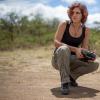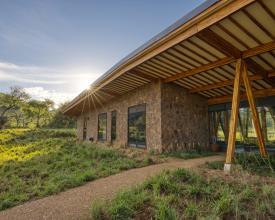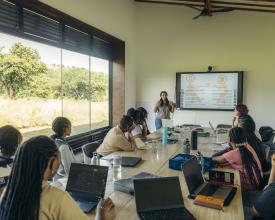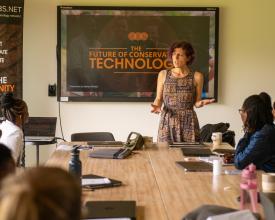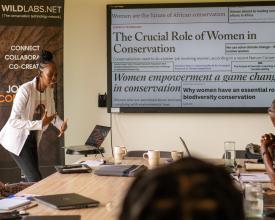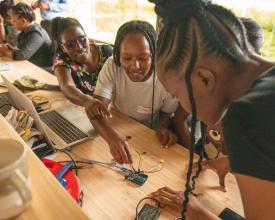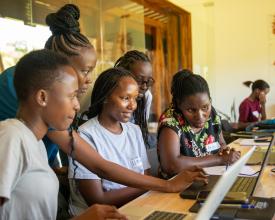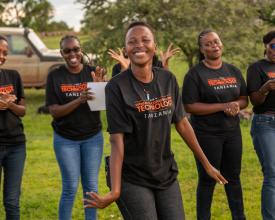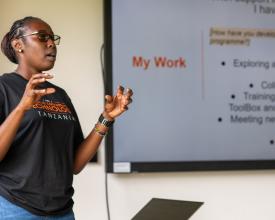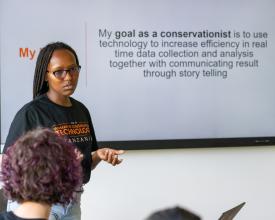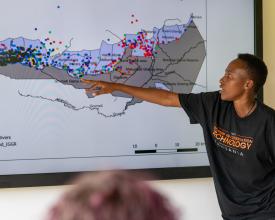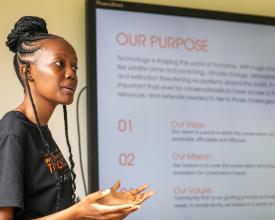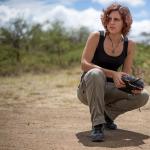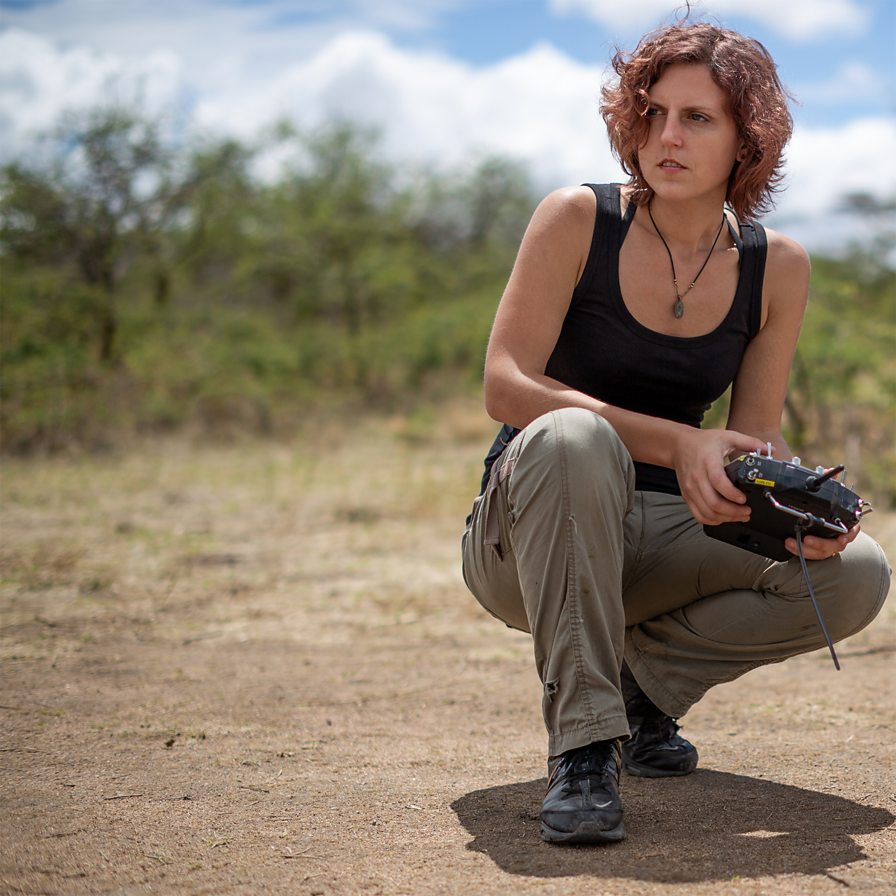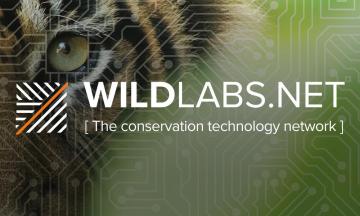
Empowering Women in Conservation Technology: Shaping Africa’s Conservation Future
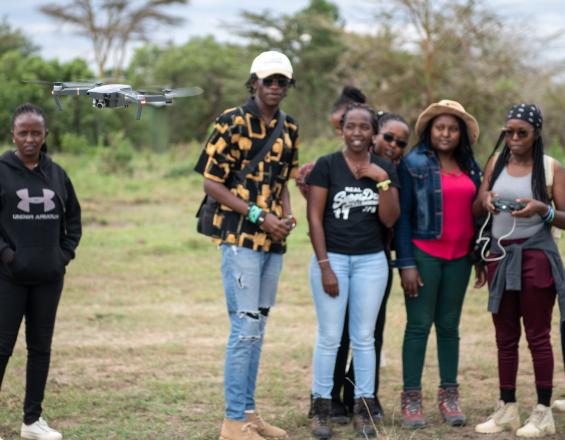
Technology transforms how conservationists combat environmental threats. While tech tools are becoming more accessible, the knowledge to use them remains unequally distributed. To address gender and geographic disparities, we developed a training program that equips women from the Global South with conservation technology skills. The program combines classroom instruction with hands-on experience in tools used for biodiversity monitoring, protected area management, and human-wildlife coexistence. To ensure relevance and lasting impact, we partner with local female technology experts who serve as instructors and mentors. Further, we fund participants to launch tech-based conservation projects and provide ongoing professional development and alumni support. This program helps women build technical portfolios and pursue academic and conservation leadership roles. Our vision is to create a global network of emerging female conservation leaders, promoting gender equity, regional capacity, and locally led biodiversity protection.
Context
Challenges addressed
Global assessments consistently highlight significant gender gaps in access to conservation technology tools, training, and support. These disparities are particularly acute in the Global South—areas that harbor the highest levels of biodiversity and face the most pressing conservation threats.
Our program directly addresses these imbalances by equipping women in emerging economies with skills, resources, and on-going mentorship to lead technology-enabled conservation efforts. We focus on building female capacity across a spectrum of roles: from future researchers to policy advocates and community leaders who are critical to driving on-the-ground change.
This approach strengthens local scientific research communities, challenges neo-colonial power structures, and supports inclusive and context-specific biodiversity solutions. Graduates of our program have gone on to influence ongoing conservation strategies, launch new initiatives, and assume leadership positions, demonstrating the systemic impact of this work.
Location
Process
Summary of the process
Collaborating with local host institutions and experts ensures our trainings are grounded in local conservation challenges. Our partners deliver standardized, modular learning materials while contributing unique perspectives as women navigating male-dominated fields, enhancing the program’s relevance for participants. Connecting our participants with these local experts further helps established strong regional networks and communities of practice.
Hands-on engagement with technology tools enables participants to gain practical skills that are often difficult to access in their regions. By introducing these tools early in participants’ careers, we create pathways for long-term integration into their future work.
Seed funding and post-program support empower participants to translate this training into tangible conservation solutions and continued career growth. Alumni remain actively connected, continuing to collaborate, share opportunities, and raise their voices on the global stage.
Crucially, the program fosters a supportive network of women in conservation tech. Often, this is the first time our participants have engaged in an all-female experience. These safe, inclusive spaces promote peer learning, long-term mentorship, and collective advocacy.
Building Blocks
Forming partnerships with local institutions
Host institutions are selected based on their capacity to support both classroom and field-based instruction, and on their engagement with active conservation challenges where technology plays a meaningful role. For instance, the RISE Grumeti Fund in Tanzania is an ideal training site, offering educational facilities, student accommodations, and running active, tech-enabled initiatives such as anti-poaching and rhino protection programs.
Furthermore, we prioritize institutions that share our commitment to advancing education for women and early-career conservationists, have strong ties to local conservation and research communities, and demonstrate leadership in integrating technology into conservation practice. These partnerships are essential to ensuring our program is both sustainable and deeply embedded in the communities it aims to serve.
Enabling factors
- Local partners with aligned visions in education, upskilling, and empowerment
- On-the-ground support from women within the host and collaborating organizations
- Networks of experienced local educators and trainers in the conservation technology space
Lesson learned
- Host institutions with strong ties to local conservation, research, and government networks are best positioned to identify and recruit experienced female professionals to serve as trainers and mentors.
- Institutions that already manage other training programs often have existing infrastructure and logistical systems in place, making them well-equipped to support student cohorts.
- Sites where a wide range of conservation technologies are actively in use offer students valuable, hands-on exposure to tools in real-world settings.
- A shared commitment to the program’s vision, particularly around gender equity and empowerment, is essential to creating a safe, supportive environment where women can build community, grow professionally, and develop leadership skills.
Identifying impactful mentors, trainers, and allies
Our standardized training curriculum is delivered by female experts (academics, practitioners, and government professionals) working in conservation and conservation technology within the local region. These women serve not only as instructors, but also mentors and collaborators. By centering local female role models, we help participants envision pathways for their own careers while strengthening their ties to regional research and conservation communities. We strive to foster an inclusive environment for honest dialogue around challenges of being a woman in conservation technology and encourage lasting mentorship relationships beyond the formal training period.
However, the gender gap we seek to address can make it difficult to identify and recruit female trainers in certain technical fields. In response, we have defined three distinct roles to broaden the support system for participants:
- Mentors: Local female role models who lead sessions and provide ongoing mentorship.
- Allies: Male trainers and facilitators who actively support our commitment to gender equity and inclusive training spaces.
- Trainers: Members of the international organizing team who provide additional instruction and logistical support.
Together, these individuals play a critical role in delivering content, fostering participant growth, and modeling diverse forms of leadership across the conservation technology landscape.
Enabling factors
- Keen interest from female leaders to foster the next generation of conservationists, including willingness to engage honestly in vulnerable conversations and provide career advice
- Growing interest from allies to support development of women in their field and organizations
- Funding to support attendance and honorarium for high-quality mentors and allies
Lesson learned
- We have established a code of conduct and set clear expectations up-front on how mentors and allies should engage with students during and after the program
- Mentors and allies with a background in training as well as expertise in conservation tech are preferred
- Wherever possible, we seek a combination of mid-career and established mentors, who can speak to participants about different stages of the conservation career journey
- Male allies need to be carefully selected to create a supportive, safe environment
- We maintain and cultivate female-only spaces at the workshop where male allies and trainers are not allowed
Developing core adaptable training materials
To build technical capacity across diverse conservation contexts, we have created a modular portfolio of standardized training materials that teach foundational competencies in conservation technology. These materials are organized into themed modules, such as wildlife monitoring, wildlife protection, and human-wildlife conflict, and are designed to be flexible and adaptable based on regional needs.
In collaboration with local host institutions and regionally recruited trainers, we tailor the curriculum to align with local ecological conditions, institutional priorities, regulatory frameworks, and learning styles. For example, because drone use is permitted in Kenya but restricted in Tanzania, modules are adjusted accordingly to ensure all content is actionable within the participant's home context. This approach ensures the training is both locally relevant and practically applicable, maximizing its long-term impact.
Examples of our core training portfolio include:
- Wildlife monitoring: Camera traps, biologgers, acoustic sensors, GPS tracking
- Wildlife protection: SMART, EarthRanger, infrared cameras, radios, K9 units, drones
- Human-wildlife conflict mitigation: Electric fencing, networked sensors, deterrent systems
- Cross-cutting tools: GIS and remote sensing, artificial intelligence, and introductory coding and electronics
Enabling factors
- Core materials are developed by world leading conservation technology experts
- Multiple years of programming have allowed us to refine and improve our training materials
- Annual participant feedback helps guide refinement of content and development of new topics
- Host institutions and local partners provide valuable input on the most relevant training needs
Lesson learned
- Educational systems vary significantly, even across countries in the same region. For example, certain types of trainings or activities - such as active learning approaches - may be more difficult for students from countries where education is centered on rote memorization. Understanding local learning preferences and adapting teaching methods accordingly can support deeper engagement.
- Certain technologies or methodologies, such as drones or cloud-based data storage, may be prohibited or prohibitively expensive in some regions. Partnering with local conservation technology experts ensures that we focus on accessible, actionable technologies for our participants.
- Asking local trainers develop their own materials often exceeds their time and capacity
- Using standardized materials ensures consistency and reduces variability in the type and depth of content delivered.
Focusing on hands-on engagement
Our technical training emphasizes experiential learning by giving participants direct, practical experience with conservation technologies. Whenever possible, students are encouraged to set up and deploy tools themselves in safe, low-pressure environments, creating space to experiment, make mistakes, and learn by doing. For instance, students may choose camera trap locations based on the classroom training module, then evaluate the effectiveness of their decisions by analyzing the resulting data. This process helps bridge theory and practice while building confidence in problem-solving and tool use.
In cases where participants cannot operate the tools directly, trainers and field practitioners from host institutions provide live demonstrations, such as tracking wildlife using GPS or operating drones, ensuring students still gain exposure to how these technologies function in real-world conservation settings.
Enabling factors
- Access to technology tools at host institution for practical use
- Opportunities for students to trial and test tools themselves
- Experience instructors to provide guidance and support
Lesson learned
- When paired with supporting background information, we have found these hands-on experiences to be more impactful than traditional lectures or merely observing technology in use
- Providing opportunities to engage with the entire lifecycle of a technology (e.g., from set up and deployment to data collection and analysis) better prepares students for using these technologies in their own projects
Strengthening early career potential
We select participants who are at the beginning stages of their careers, such as those who have completed their bachelor’s degrees and are entering the NGO or conservation workforce or embarking on higher education.The goal is to identify participants whose careers would benefit the most from the type and amount of training, funding, mentorship, and support we provide. Over the past two years, we’ve recruited at least one participant from a non-academic background who nevertheless possesses extensive on-the-ground experience. These individuals have thrived in the program, highlighting an opportunity to further cater to this audience in future iterations.
Enabling factors
- Strong networks with local academic institutions and regional NGOs help us attract a large pool of qualified applicants (~200 applications per year)
- Tailored educational materials that align with the needs of early-career participants
- Community of same-stage participants form strong and enduring connections
Lesson learned
- Initially, we included participants at various career stages, but we found that older, more experienced individuals have different needs and require a distinct program tailored to their experience level
- Our entry-level training materials were less useful for women with more experience in the field
Unlocking future impact: Funding and professional development
For many conservationists, including our participants, the knowledge to effectively use conservation technology is not enough without the funding to access the tools. Recognizing this barrier, we provide each participant with USD$500 in seed funding to support the implementation of their conservation solutions. Participants are required to propose and carry out projects, which have ranged from building predator-proof bomas and underwater camera traps to developing AI tools, mobile apps, and community-driven citizen science initiatives. Each participant is required to report on their project’s progress over the following year, fostering accountability and impact tracking.
To ensure long-term sustainability, we also deliver training in grant writing, proposal development, and funder engagement to equip participants with the skills needed to secure sustained future funding. Ongoing mentorship and support also continue beyond the initial training. Our team, along with a growing alumni network, provides guidance on grant applications, reference letters, and professional development opportunities. Many of the projects and collaborations initiated during the program have led to graduate study, published research, and conference presentations, reinforcing participants’ continued growth as conservation leaders.
Enabling factors
- Support from donors who fund seed grants
- Ongoing dedication and investment of trainers and mentors
Lesson learned
- Students are required to submit two updates and a financial report for their grant. Ensuring follow-up on these submissions requires dedicated effort and engagement from the core team
- Students have reported that being able to list the seed funding received through our program on their CVs has helped them secure additional funding opportunities in the future.
Impacts
To date, we have trained 35 East African women in conservation technology. Our participants have gone on to secure leadership roles in conservation organizations, win international awards, and contribute to global conservation dialogues (see Links). Our alumni form an active community via our online platform and WhatsApp to share opportunities, troubleshoot challenges, and support one another in a male-dominated field.
In addition to training, each participant receives a $500 grant. These funds have catalyzed innovative protected area management, species monitoring, and human-wildlife coexistence projects. Tools developed or deployed include camera traps, underwater imaging, AI-assisted workflows, mobile data collection apps, and community engagement platforms. Read more at:
- wildlabs.net/collection/making-progress-women-conservation-technology-programme-kenya
- wildlabs.net/collection/scaling-impact-women-conservation-technology-programme-tanzania-2023
Our participants consistently report in annual post-course surveys that skillsets and portfolios gained during our program enabled them secure new opportunities. As shared in links above, 4 participants have received internships supported by our program and partners, 1 has begun a new career as a conservation tech trainer, 3 have gone on to receive scholarships, 5 have published papers, and many others have advanced within their conservation organizations.
Beneficiaries
Early-career women in East Africa who aspire to leadership roles in NGOs, academia, and government. To maximize accessibility, we cover all costs, including childcare - a barrier that often prevents women from accessing the same training opportunities as men.
Additionally, explain the scalability potential of your Solution. Can it be replicated or expanded to other regions or ecosystem?
As conservation technologies are used in diverse ecosystems worldwide – and gender gaps in their application are similarly pervasive – there is no limit on the scope of where this program can have impact. From the outset, this program was designed to be scalable and replicable across institutions in East Africa, with eyes on broader global geographies.
To support this scalability, we developed a flexible core framework with foundational coursework modules that can be adapted to fit local challenges and contexts. Instead of fixed trainers, we established clear guidelines for selecting local mentors and teachers, as well as a code of conduct for invited experts. Comprehensive resources—such as detailed instructions for identifying and engaging host institutions, selecting applicants, and conducting workshops and remote training sessions—ensure that any institution can implement the program effectively.
The program has already been successfully deployed at multiple sites in Kenya and Tanzania, fostering a strong regional network of Women in Conservation Technology alumni who continue to collaborate and support one another. While we are now working with partners in additional African countries to expand this network further, we ultimately aim to scale the program to new regions. Future plans include syndicating course materials and offering “train-the-trainer” sessions to extend the program’s reach and create a global network of conservation technology leaders.
We have also seen strong interest from women in conservation who are not on academic career paths but would greatly benefit from the technical skills our program provides. This includes rangers, protected area managers, and practitioners working on human-wildlife conflict mitigation. Over the past two years, we have begun integrating these professionals into our training and have identified significant potential to adapt and tailor our curriculum to better meet their needs and support their critical, field-based roles.
Global Biodiversity Framework (GBF)
Sustainable Development Goals
Story
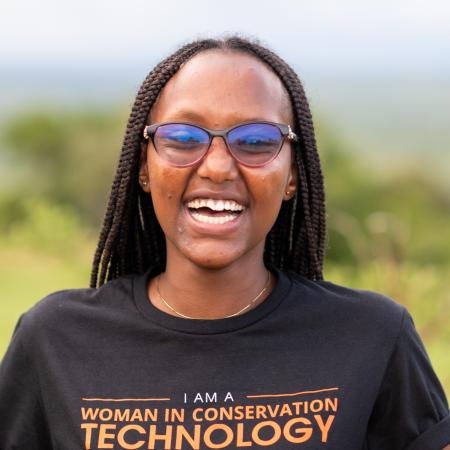
Each of our three dozen participants has launched innovative conservation initiatives across diverse ecosystems, addressing issues such as biodiversity loss, climate resilience, human-wildlife coexistence, and community engagement. You can follow their progress and project updates on our online platform (Kenya; Tanzania).
Beyond their individual projects, alumni have also united to raise global awareness of gender and geographic inequities in access to conservation technology. Listen to our alumni explore these issues at the SHE Changes Climate and EarthRanger User Conferences.
While each alumna’s path has been inspiring, Eliminatha Ambross offers a powerful example of the program’s impact. Below, we share excerpts from her interviews and reflections:
I’m Eliminatha Ambross, an enthusiastic conservationist who recently participated in the Women in Conservation Technology 2023 program in Tanzania. I was introduced to cutting-edge tools like camera traps. These tools sparked my interest in technology's role in conservation.
Following the WICT workshop, I was thrilled to secure a three-month internship with the Grumeti Fund, focusing on their camera trap project. This experience was later extended to six months, providing me with an in-depth, hands-on opportunity to engage with wildlife conservation technology. During my time there, I learned the basics of setting up camera traps in the field, collecting and analyzing data, and using our findings to inform conservation strategies and policymaking. This internship was not just a job; it was a pivotal steppingstone in my journey, offering me practical skills and deep insights into the intersection of technology and conservation.
The skills and experiences I gained during my internship were instrumental in securing a spot in the MSc in Conservation Management of African Ecosystems program at the University of Glasgow.With the support of a fully funded scholarship from the Karimjee Foundation, I am now poised to delve deeper into integrating technology in conservation research and practice. I am excited to expand my knowledge and explore innovative ways to protect our ecosystems.
My goal is to leverage these insights to contribute to sustainable conservation efforts in Africa and beyond. The road ahead is full of promise, and I am committed to continuing my efforts in integrating technology with conservation for a better, sustainable world.
